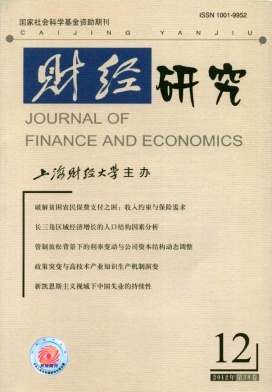政策突变与高技术产业知识生产机制演变——来自行业面板数据的证据
财经研究 2012 年 第 38 卷第 12 期, 页码:76 - 86
摘要
参考文献
摘要
文章将产业政策变化分为渐变和突变两种类型,以我国高技术产业5个分行业1996-2010年的数据为样本,利用分段回归的计量方法,分析了2004年产业政策突变在产业知识生产机制演变中的作用。研究发现,各投入要素的产出弹性均发生了较大变化,其中R&D资金投入具有最高的产出弹性,其贡献率在2004年后得到进一步的提升,国外技术引进从正产出效应转变为负产出效应,而国内技术引进的产出效应则得到较大的提升。
[1]邓明,钱争鸣.我国省际知识存量、知识生产与知识的空间溢出[J].数量经济技术经济研究,2009,(5):42-53.
[2]蒋殿春,夏良科.外商直接投资对中国高技术产业技术创新作用的经验分析[J].世界经济,2005,(8):3-10.
[3]刘小鲁.我国创新能力积累的主要途径:R&D,技术引进,还是FDI[J].经济评论,2011,(3):88-96.
[4]潘文卿,李子奈,刘强.中国产业间的技术溢出效应:基于35个工业部门的经验研究[J].经济研究,2011,(7):18-29.
[5]王锐淇,张宗益.区域创新能力影响因素的空间面板数据分析[J].科研管理,2010,(3):17-26.
[6]王玲,Szirmai.高技术产业技术投入和生产率增长之间关系的研究[J].经济学(季刊),2008,7(3):913-932.
[7]魏守华,姜宁,吴贵生.本土技术溢出与国际技术溢出效应———来自中国高技术产业创新的检验[J].财经研究,2010,(1):54-65.
[8]吴延兵.自主研发、技术引进与生产率———基于中国地区工业的实证研究[J].经济研究,2008,(8):51-64.
[9]吴玉鸣,何建坤.研究型大学研发与首都区域专利产出的动态计量经济分析[J].科研管理,2007,(2):93-98.
[10]吴玉鸣,何建坤.研发溢出、区域创新集群的空间计量经济分析[J].管理科学学报,2008,(4):59-66.
[11]严成樑,周铭山,龚六堂.知识生产、创新与研发投资回报[J].经济学(季刊),2010,9(3):1051-1070.
[12]张倩肖,冯根福.三种R&D溢出与本地企业技术创新———基于我国高技术产业的经验分析[J].中国工业经济,2007,(11):64-72.
[13]Griliches Z.Issues in assessing the contribution of research and development to produc-tivity growth[J].Bell Journal of Economics,1979,10:92-116.
[14]Jaffe A B.Real effects of academic research[J].American Economic Review,1989,79:957-970.
[15]Romer P.Endogenous technological change[J].Journal of Political Economy,1990,98:71-102.
[16]Jones C.R&D-based models of economic growth[J].Journal of Political Economy,1995,103:759-784.
[17]Fischer M,Varga A.Spatial knowledge spillovers and university research:Evidencefrom Austria[J].Annals of Regional Saence,2003,37:303-322.
[18]Fischer M,Scherngell T,Jansenberger E.Geographic localisation of knowledge spillo-vers:Evidence from high-tech patent citations in Europe[J].Annals of Regional Sci-ence,2009,43:839-858.
[19]Greunz L.Industrial structure and innovation evidence from European regions[J].Jour-nal of Evolutionary Economics,2004,14:563-592.
[20]Heshmati A.A generalized knowledge production function[J].IFCAI Journal of Indus-trial Economics,2009,6(1):7-39.
[21]Piergiuseppe M,Carmelo P,Giuseppina T.Research,knowledge spillovers and innova-tion:Evidence from the Italian manufacturing sector[R].Department of Economics,Mathematics and Statistics,Birkbeck,University of London,No.0713,2007.
[22]Kinoshita Y.R&D and absorptive capacity technology spillovers Via FDI:Innovationand Absorptive Copoacity[R].William Davidson Institute Working Paper,No.349,2000.
[23]Nietoa M,Quevedo P.Absorptive capacity,technological opportunity,knowledge spill-overs,and innovative effort[J].Technovation,2005,25:1141-1157.
[24]Chang C,Robin S.Doing R&D and/or importing technologies:The critical importanceof firm size in Taiwan’s manufacturing industries[J].Review of Industrial Organiza-tion,2006,29:253-278.
[25]Lee J.Technology imports and R&D efforts of Korean manufacturing firms[J].Journalof Development Economics,1996,50:197-210.
[26]Liu X H,Buck T.Innovation performance and channels for international technologyspillovers:Evidence from Chinese high-tech industries[J].Research Policy,2007,36(3):355-366.
[27]Pessoa A.Ideas driven growth:The OECD evidence[J].Portuguese Economic Journal,2005,4(1):46-67.
[28]de Groot H L F.Nijkamp P,Acs Z.Knowledge spill-overs,innovation and regional de-velopment[J].Papers in Regional Science,2001,80(3):249-253.
[29]Nadiri M I.Innovations and technological spillovers[R].NBER Working Papers,No.4423,1993.
[30]Bernstein J I,Mamuneas T P.R&D depreciation,stocks,user costs and productivitygrowth for US R&D intensive industries[J].Structural Change and Economic Dynam-ics,2006,17(1):70-98.
[31]Gutierrez L.On the power of panel cointegration tests:A Monte Carlo comparison[J].Economics Letters,2003,80:105-111.
①本文采用《中国高技术产业统计年鉴》中的行业划分方式,将我国高技术产业分为医药制造业、航空航天器制造业、电子及通信设备制造业、电子计算机及办公设备制造业、医疗设备及仪器仪表制造业等五大类。
②不同专利类型从申请到通过审批被正式授权需要不等的时间,在我国发明专利一般需要1年半至3年左右,实用新型专利一般需要6至12个月,外观设计专利一般需要3至6个月。
[2]蒋殿春,夏良科.外商直接投资对中国高技术产业技术创新作用的经验分析[J].世界经济,2005,(8):3-10.
[3]刘小鲁.我国创新能力积累的主要途径:R&D,技术引进,还是FDI[J].经济评论,2011,(3):88-96.
[4]潘文卿,李子奈,刘强.中国产业间的技术溢出效应:基于35个工业部门的经验研究[J].经济研究,2011,(7):18-29.
[5]王锐淇,张宗益.区域创新能力影响因素的空间面板数据分析[J].科研管理,2010,(3):17-26.
[6]王玲,Szirmai.高技术产业技术投入和生产率增长之间关系的研究[J].经济学(季刊),2008,7(3):913-932.
[7]魏守华,姜宁,吴贵生.本土技术溢出与国际技术溢出效应———来自中国高技术产业创新的检验[J].财经研究,2010,(1):54-65.
[8]吴延兵.自主研发、技术引进与生产率———基于中国地区工业的实证研究[J].经济研究,2008,(8):51-64.
[9]吴玉鸣,何建坤.研究型大学研发与首都区域专利产出的动态计量经济分析[J].科研管理,2007,(2):93-98.
[10]吴玉鸣,何建坤.研发溢出、区域创新集群的空间计量经济分析[J].管理科学学报,2008,(4):59-66.
[11]严成樑,周铭山,龚六堂.知识生产、创新与研发投资回报[J].经济学(季刊),2010,9(3):1051-1070.
[12]张倩肖,冯根福.三种R&D溢出与本地企业技术创新———基于我国高技术产业的经验分析[J].中国工业经济,2007,(11):64-72.
[13]Griliches Z.Issues in assessing the contribution of research and development to produc-tivity growth[J].Bell Journal of Economics,1979,10:92-116.
[14]Jaffe A B.Real effects of academic research[J].American Economic Review,1989,79:957-970.
[15]Romer P.Endogenous technological change[J].Journal of Political Economy,1990,98:71-102.
[16]Jones C.R&D-based models of economic growth[J].Journal of Political Economy,1995,103:759-784.
[17]Fischer M,Varga A.Spatial knowledge spillovers and university research:Evidencefrom Austria[J].Annals of Regional Saence,2003,37:303-322.
[18]Fischer M,Scherngell T,Jansenberger E.Geographic localisation of knowledge spillo-vers:Evidence from high-tech patent citations in Europe[J].Annals of Regional Sci-ence,2009,43:839-858.
[19]Greunz L.Industrial structure and innovation evidence from European regions[J].Jour-nal of Evolutionary Economics,2004,14:563-592.
[20]Heshmati A.A generalized knowledge production function[J].IFCAI Journal of Indus-trial Economics,2009,6(1):7-39.
[21]Piergiuseppe M,Carmelo P,Giuseppina T.Research,knowledge spillovers and innova-tion:Evidence from the Italian manufacturing sector[R].Department of Economics,Mathematics and Statistics,Birkbeck,University of London,No.0713,2007.
[22]Kinoshita Y.R&D and absorptive capacity technology spillovers Via FDI:Innovationand Absorptive Copoacity[R].William Davidson Institute Working Paper,No.349,2000.
[23]Nietoa M,Quevedo P.Absorptive capacity,technological opportunity,knowledge spill-overs,and innovative effort[J].Technovation,2005,25:1141-1157.
[24]Chang C,Robin S.Doing R&D and/or importing technologies:The critical importanceof firm size in Taiwan’s manufacturing industries[J].Review of Industrial Organiza-tion,2006,29:253-278.
[25]Lee J.Technology imports and R&D efforts of Korean manufacturing firms[J].Journalof Development Economics,1996,50:197-210.
[26]Liu X H,Buck T.Innovation performance and channels for international technologyspillovers:Evidence from Chinese high-tech industries[J].Research Policy,2007,36(3):355-366.
[27]Pessoa A.Ideas driven growth:The OECD evidence[J].Portuguese Economic Journal,2005,4(1):46-67.
[28]de Groot H L F.Nijkamp P,Acs Z.Knowledge spill-overs,innovation and regional de-velopment[J].Papers in Regional Science,2001,80(3):249-253.
[29]Nadiri M I.Innovations and technological spillovers[R].NBER Working Papers,No.4423,1993.
[30]Bernstein J I,Mamuneas T P.R&D depreciation,stocks,user costs and productivitygrowth for US R&D intensive industries[J].Structural Change and Economic Dynam-ics,2006,17(1):70-98.
[31]Gutierrez L.On the power of panel cointegration tests:A Monte Carlo comparison[J].Economics Letters,2003,80:105-111.
①本文采用《中国高技术产业统计年鉴》中的行业划分方式,将我国高技术产业分为医药制造业、航空航天器制造业、电子及通信设备制造业、电子计算机及办公设备制造业、医疗设备及仪器仪表制造业等五大类。
②不同专利类型从申请到通过审批被正式授权需要不等的时间,在我国发明专利一般需要1年半至3年左右,实用新型专利一般需要6至12个月,外观设计专利一般需要3至6个月。
引用本文
兰宏, 聂鸣. 政策突变与高技术产业知识生产机制演变——来自行业面板数据的证据[J]. 财经研究, 2012, 38(12): 76–86.
导出参考文献,格式为:





 6158
6158  3034
3034

